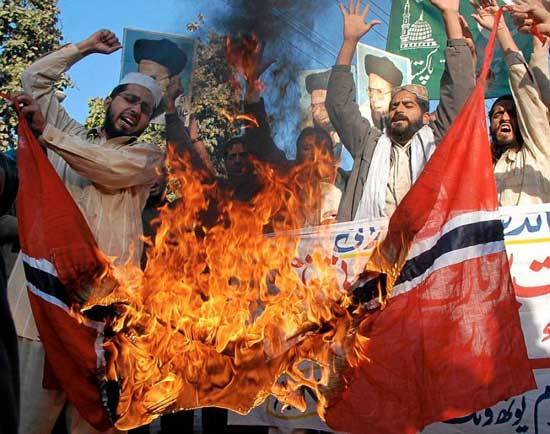There may be no Hindus left in Bangladesh in 30 years
 par
par
The tragic tale of the Hindus of East Bengal (which later became East Pakistan and is now Bangladesh) must start with the Noakhali genocide, for it was a prelude to what would unravel in the years to come. In 1946, Noakhali district in south eastern Bangladesh, was the scene of a gruesome carnage which the historian Yasmin Khan described as being defined by “clear strategic organization (roads in and out of the almost inaccessible region were cordoned off)” (The Great Partition: The Making of India and Pakistan. Yale University Press, 2008); at least 5,000 Hindus were massacred, hundreds of Hindu women raped and thousands forcibly converted to Islam; many more fled to India. Even Mahatma Gandhi’s peace mission to Noakhali failed to quell the atrocities against Hindus which continued unabated during his stay. Exasperated, Gandhi left Noakhali, urging the Hindus there to “Quit Noakhali or Die” (NY Times. 8 April 1947).
DECREASING POPULATION
Gandhi’s words proved prescient for the entire Hindu community of East Bengal for decades to come after 1946: they either perished or fled. The Hindu population has undergone a steady attrition over the years, from 28% in 1940 to 8.96% in 2011, with especially two periods of sharp decline—the first around the time of partition and the second during the 1971 Bangladesh War that resulted in the liberation of Bangladesh. However, even after the emergence of Bangladesh, the Hindu community has contracted—from 13.5% in 1974 to 8.96% in 2011—a nearly 33% decline, which is humungous in demographic terms. These dwindling numbers are a stark indicator of the deeply hostile anti-Hindu environment prevalent in that country.
Professor Abul Barakat of Dhaka University in his recently published book, The Political Economy of Reforming Agriculture: Land Water Bodies in Bangladesh, writes that “there will be no Hindus left within Bangladesh within 30 years…The rate of the exodus over the past 49 years points to that direction.” As per his research, around 11.3 million Hindus were compelled to flee Bangladesh due to religious persecution from 1964 to 2013.
GENOCIDE OF 1971
Atrocities against Hindus culminated during the Bangladesh Liberation War. It was arguably the darkest period for Bangladeshi Hindus—they became the victims of horrendous genocide.
Senator Edward Kennedy in a report submitted to US Senate Judiciary Committee (1 November, 1971) categorically stated: “Field reports to the US government, countless eye-witness journalistic accounts, reports of international agencies such as World Bank and additional information available to the subcommittee document the reign of terror which grips East Bengal (East Pakistan). Hardest hit have been members of the Hindu community who have been robbed of their lands and shops, systematically slaughtered, and in some places, painted with yellow patches marked ‘H’. All of this has been officially sanctioned, ordered and implemented under martial law from Islamabad.”
In Gary Bass’ book, The Blood Telegram (Vintage, 2014), Archer Blood, who was the American Consul General in Dhaka, speaks of the “international moral obligations to condemn genocide…of Pakistani Hindus”.
And David Bergman, an investigative journalist based in Bangladesh, in an op-ed column (The Politics of Bangladesh’s Genocide Debate, 5 April 2016, New York Times) also refers to the Hindu genocide: “There is no question that there were many atrocities, including rape, deportation and massacres of civilians, carried out by the Pakistani Army, aided at times by pro-Pakistani militias. Some of these included members of the student wing of Jamaat-e-Islami, an Islamist party that remains a powerful force in Bangladesh today. There is an academic consensus that this campaign of violence, particularly against the Hindu population, was a genocide.”
Estimates of the actual number of deaths vary from a ridiculous low 26,000 put out by the Pakistan government (Hamood-ur-Rahman Commission) to a high of 3 million circulating in the international media. The official position from Bangladesh concurs with the figure of 3 million.
R.J. Rummel, in his book, Statistics of Democide: Genocide and Mass Murder Since 1900 (Chapter 8) concludes: “Consolidating both ranges, I give a final estimate of Pakistan’s democide to be 300,000 to 3,000,000, or a prudent 1,500,000.”
Using these estimates, the final casualty figures for Hindus sum up to anywhere between 1.2 to 2.4 million, as Hindus accounted for nearly 80% of those killed—a mind numbing figure by any standards.
CONSTITUTIONAL STATUS
For the greater part of their existence since 1947, the Hindus of Bangladesh have lived as second class citizens—first under the Islamic theocracy of Pakistan till 1971 and subsequently under some of the governments in Bangladesh.
Sheikh Mujibur Rehman did include secularism as one of the four core governing principles in the first Constitution of Bangladesh in 1972. However, this was short-lived. In 1975, a military coup deposed Sheikh Mujibur Rehman in the name of the “Islamic Republic of Bangladesh”.
Subsequently, General Ziaur Rahman further fortified the religious basis of the Constitution by deleting “secularism” as one of the four major fundamental principles of state policy and adding an Islamic invocation above the preamble (5th Amendment, 1979). Next, General Ershad deemed Islam as the state religion by introducing Article 2A, which averred that “the state religion of the Republic is Islam but other religions may be practiced in peace and harmony in the Republic” (8th Amendment, 1988).
In 2011, Sheikh Hasina restored “secularism” to the Constitution, but maintained Islam as the state religion and made no changes to the preamble, retaining its religious invocation (15th Amendment). With an officially sanctioned state religion, secularism is reduced to naught sans any practical impact—the Hindus and other minorities continue to be for all intents and purposes second class citizens.
There have been other discriminatory orders passed by the government. In 1993, the Home Ministry asked commercial banks to regulate withdrawal of cash by Hindus and stop disbursement of loans to the Hindu community in districts bordering India.
COMMUNAL VIOLENCE AND RELIGIOUS INTIMIDATION
Their Constitutionally ordained secondary status makes Hindus vulnerable to mob violence orchestrated by fundamentalist groups especially during election times and during periods of social turmoil.
In 2001, following the electoral victory of the BNP led by Khaleda Zia, her supporters unleashed a systematic campaign of violence against Hindus that went on for about 150 days. A judicial commission probing this violence documented about 18,000 incidents of major crime; about 1,000 Hindu women were raped and 200 were victims of gang rape. Nearly 500,000 Hindus fled to India (The Daily Star, 2 December 2011; Hindu American Foundation report).
When the International Crimes Tribunal indicted several Jamaat members in 2013 for war crimes against Hindus during the 1971 Bangladesh atrocities, their supporters retaliated by attacking Hindus: Hindu properties and businesses were looted, women were abducted and raped and temples were desecrated. Overall, more than 50 Hindu temples were destroyed and over 1,500 Hindu homes were burnt spread out over 20 districts.
Hindu priests are regularly targeted and intimidated for preaching Hinduism. In February 2016, Jogeshwar Roy, a 55-year-old Hindu priest was beheaded by Islamic militants, while preparing for prayers inside the Deviganj temple in Panchagarh district.
HINDU PROPERTY
In addition to the fragility of their lives, government laws ensure that land and property owned by Hindus is not secure as well. In 1965 after the Indo-Pakistan War, Pakistan promulgated the Enemy Property Act (EPA) that gave the government unbridled powers to appropriate enemy property—a euphemism for Hindu owned assets. The new Republic of Bangladesh retained the EPA under a new name the Vested Property Act (1974) whereby the Government of Bangladesh vested itself with the “enemy” properties previously seized since the 1965 War and continued to use the discriminatory law to confiscate Hindu land.
In 2001, the Awami League made an attempt to restore Hindu property to its rightful owners by the Restoration of Vested Property Act, 2001; but it was nothing more than an eyewash. The requirements were too burdensome and failed to translate into any benefit at the ground level.
Approximately 1.2 million Hindu families, or 44% of all Hindu households, have been affected EPA/VPA: Hindus have been dispossessed of more than 2 million acres of land. Even after the Restoration of Vested Property Act passed in 2001, land encroachment involving Hindu land has continued but mostly during BNP governments. (Rabindranath Trivedi. Retired Additional Secretary and former Press Secretary to the President of Bangladesh. The legacy of enemy turned vested property act in Bangladesh. Asian Tribune. 29 May 2007.)
CONCLUSION
In all this oppression, the Awami League has offered a glimmer of hope and demonstrated some semblance of right and wrong by instituting a judicial probe into the post-election violence of 2001 and setting up the International Crimes Tribunal to try the perpetrators of the 1971 war crimes. It must be lauded. But overall these efforts have been insufficient. So instead of questioning the need for a CAA as Sheikh Hasina did or Bangladeshi diplomats calling off their visits to India in a huff, Bangladesh must pledge to do more to bolster the confidence its Hindu minority.
In summary, the Hindus of East Bengal have had an unenviable existence since 1947: they have been the victims of an unprecedented genocide, their properties continue to be illegally usurped, their temples continue to be desecrated and their women are fair target for their detractors—forcing them to flee the country in droves to the only land where they hope to find relief—India.
So, I reiterate this question to the CAA protestors that I asked recently with regard to the Hindus of Pakistan: Can anyone with even an iota of conscience deny this community refuge?




